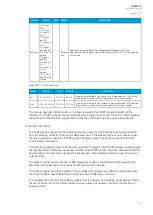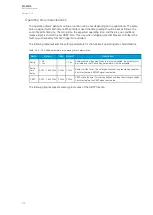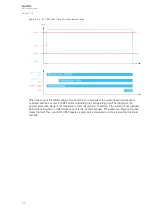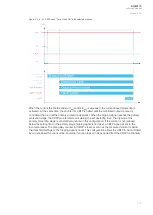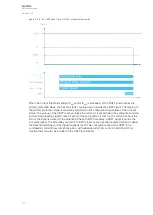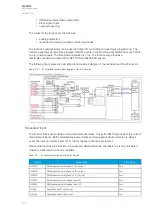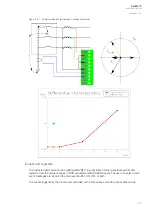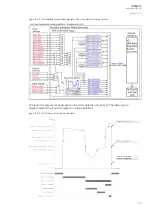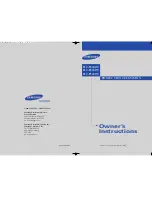
Event number
Event channel
Event block name
Event code
Description
2820
44
CBF1
4
CBFP ON
2821
44
CBF1
5
CBFP OFF
2822
44
CBF1
6
Block ON
2823
44
CBF1
7
Block OFF
2824
44
CBF1
8
DO monitor ON
2825
44
CBF1
9
DO monitor OFF
2826
44
CBF1
10
Signal ON
2827
44
CBF1
11
Signal OFF
2828
44
CBF1
12
Phase current ON
2829
44
CBF1
13
Phase current OFF
2830
44
CBF1
14
Res current ON
2831
44
CBF1
15
Res current OFF
The function registers its operation into the last twelve (12) time-stamped registers. The register of the
function records the ON event process data for ACTIVATED, BLOCKED, etc. The table below
presents the structure of the function's register content.
Table. 5.3.6 - 60. Register content.
Date and
time
Event code
Trigger
current
Time to
RETRact
Time to
CBFPact
F type
S type Used SG
dd.mm.yyyy
hh:mm:ss.mss 2816-2831 Descr.
Phase and
residual currents
on trigger time
Time
remaining
before RETR
is active
Time
remaining
before CBFP
is active
Monitored
current
status
code
Activate
start
triggers
Setting
group 1...8
active
5.3.7 Low-impedance or high-impedance restricted earth fault/ cable end differential
protection (I0d>; 87N)
The low-impedance or high-impedance restricted earth fault function is used for residual differential
current measurement for transformers. This function can also be used as the cable end differential
function. The operating principle is low-impedance differential protection with bias characteristics the
user can set. A differential current is calculated with the sum of the phase currents and the selected
residual current input. In cable end differential mode the function provides natural measurement
unbalance compensation for higher operating sensitivity in monitoring cable end faults.
The restricted earth fault function constantly monitors phase currents and selected residual current
instant values as well as calculated bias current and differential current magnitudes.
The blocking signal and the setting group selection control the operating characteristics of the function
during normal operation, i.e. the user or user-defined logic can change function parameters while the
function is running.
The outputs of the function are TRIP and BLOCKED signals. The function uses a total of eight (8)
separate setting groups which can be selected from one common source. The operating mode of the
function can be changed via setting group selection.
The operational logic consists of the following:
• input magnitude selection
• input magnitude processing
A
AQ
Q-M210
-M210
Instruction manual
Version: 2.04
114
Содержание AQ-M210
Страница 1: ...AQ M210 Motor protection IED Instruction manual ...
Страница 308: ...Figure 7 4 182 Example block scheme A AQ Q M210 M210 Instruction manual Version 2 04 307 ...
Страница 329: ...Figure 8 13 204 Panel cutout dimensions and device spacing A AQ Q M210 M210 Instruction manual Version 2 04 328 ...



